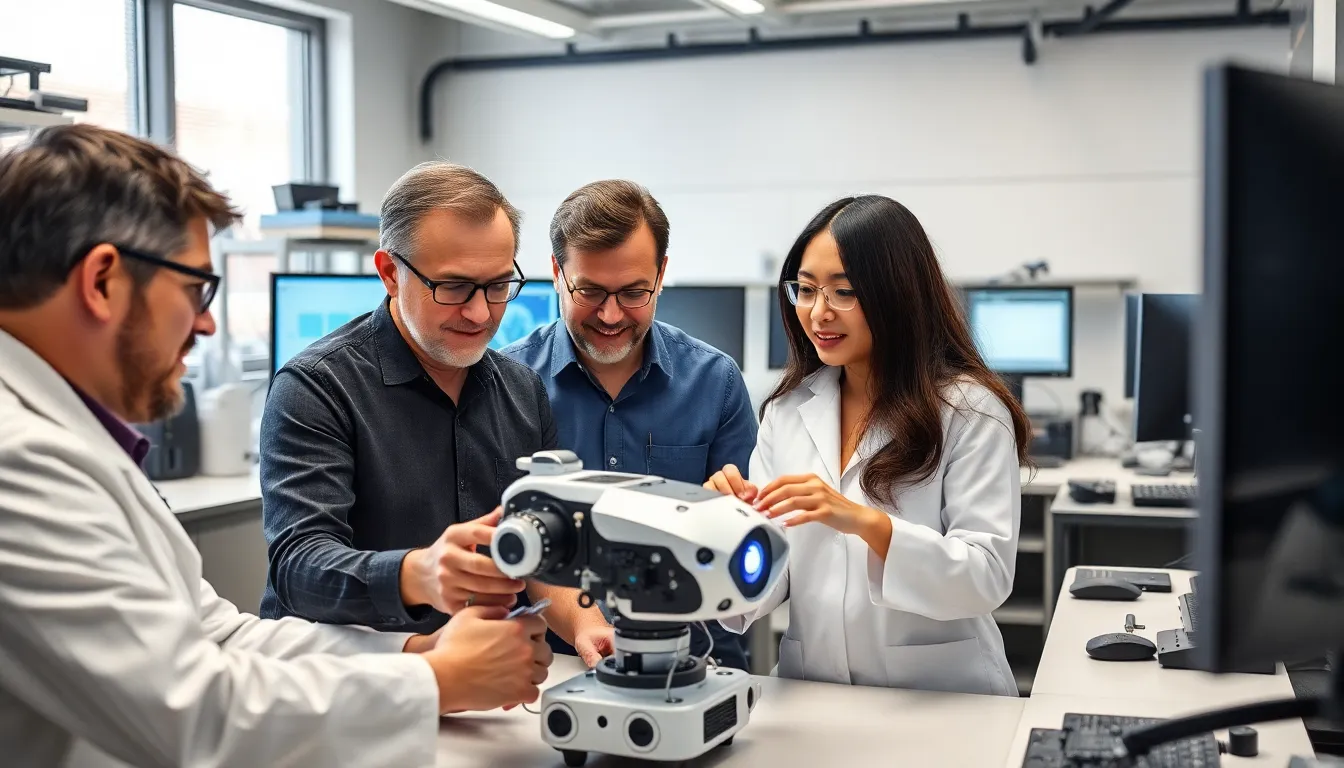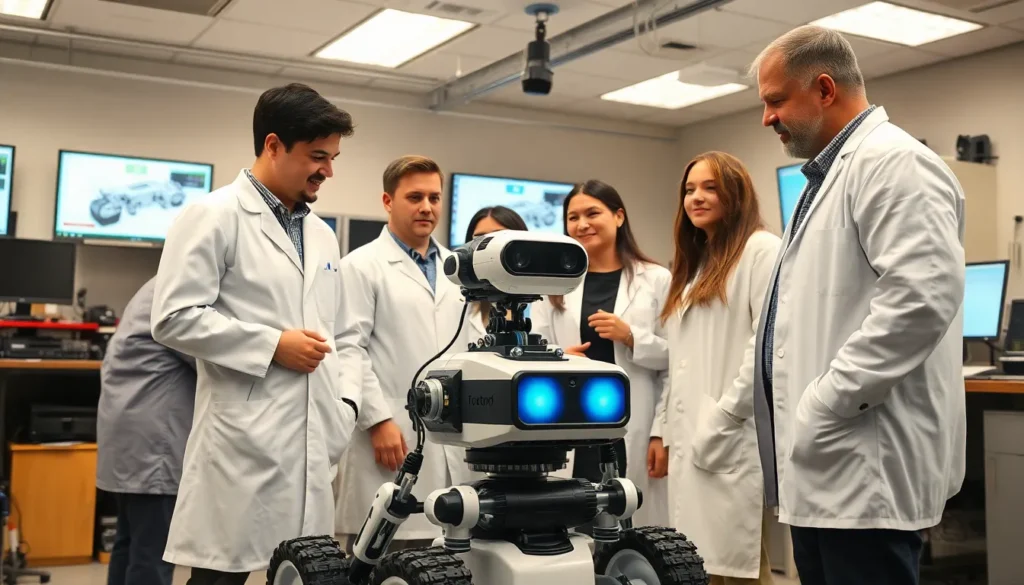Table of Contents
ToggleStanford Robotics isn’t just about building robots; it’s about crafting the future one robotic arm at a time. Nestled in the heart of Silicon Valley, this powerhouse of innovation combines cutting-edge research with a dash of creativity. Imagine a world where robots don’t just vacuum your floors but also help you cook dinner and maybe even crack a joke or two.
Overview of Stanford Robotics
Stanford Robotics operates at the intersection of technology and innovation. This organization focuses on developing advanced robotic systems that can integrate into everyday life. Researchers and engineers collaborate to push the boundaries of what robots can achieve.
Cutting-edge projects include autonomous vehicles, manipulation robots, and interactive assistants. These projects aim to redefine interaction between humans and machines. Education plays a significant role in Stanford Robotics, with numerous courses and workshops available. Students gain hands-on experience, equipping them with skills to contribute to future advancements.
Collaboration with industry partners enhances research initiatives. Partnerships allow for real-world applications of robotic innovations, bridging the gap between theory and practice. This synergy fosters an environment conducive to breakthroughs in machine learning and artificial intelligence.
Stanford Robotics also emphasizes ethical dimensions of technology. Researchers consider societal impacts and advocate for responsible robotics development. Their focus on accessibility ensures that robotic technology benefits a broader audience.
Research findings published by Stanford Robotics influence global discussions on robotics. By sharing knowledge, they establish themselves as thought leaders in the field. The lab’s commitment to innovation continuously draws attention from academia and industry alike.
With its strategic position in Silicon Valley, Stanford Robotics remains a hub for creativity and cutting-edge research. The organization is well-positioned to shape the future of robotics for generations to come.
Research Areas in Stanford Robotics

Stanford Robotics explores various research areas, advancing the field of robotics through innovative projects and applications.
Autonomous Systems
Autonomous systems focus on creating robots capable of independent operation. These robots navigate environments, make real-time decisions, and perform complex tasks without human intervention. Autonomous vehicles serve as a prominent example, utilizing advanced sensors and algorithms for path planning. Research in this area enables robots to adapt to dynamic surroundings, enhancing their utility in fields like transportation, agriculture, and exploration. Notably, Stanford researchers leverage machine learning techniques to improve decision-making processes, ensuring safe and efficient operation.
Human-Robot Interaction
Human-robot interaction emphasizes seamless communication between humans and robots. This research area investigates designing intuitive interfaces that enhance user experience. Robots increasingly assist in various settings, including homes, healthcare facilities, and workplaces. Understanding social dynamics allows researchers to develop robots that can respond appropriately to human emotions and commands. Interactive assistants represent a significant focus, facilitating everyday tasks while promoting trust and companionship. By engaging users effectively, these systems improve productivity and comfort.
Robot Design and Fabrication
Robot design and fabrication involve creating innovative robotic platforms and components. Practical engineering principles play a crucial role in developing functional and efficient robots. Researchers prioritize creating adaptable designs that cater to diverse applications, such as manufacturing, service industries, and exploration missions. Materials selection and manufacturing techniques influence robot performance, durability, and cost-effectiveness. This area encourages collaboration across disciplines, merging mechanical engineering with computer science to create robotic systems that push technological boundaries.
Notable Projects and Innovations
Stanford Robotics showcases various notable projects and innovations that greatly impact the robotics landscape.
Stanford Racing Team
The Stanford Racing Team focuses on developing autonomous vehicles. Participants engage in designing and programming robots capable of navigating complex environments. An example includes the Roborace team, which aims to compete in high-speed, fully autonomous racing events. This project emphasizes advanced perception systems and real-time decision-making algorithms. Collaborations with automotive engineers and computer scientists ensure that the vehicles meet rigorous performance standards. The team’s efforts contribute significantly to the broader autonomous vehicle research community, inspiring future developments in self-driving technology.
Fetch Robotics
Fetch Robotics specializes in mobile robotics solutions for warehouse operations. The robots designed by Fetch automate tasks such as material transport and inventory management. A key innovation is the collaborative use of autonomous mobile robots to enhance productivity. These robots interact seamlessly with existing workflows, enabling companies to optimize logistics. Their development prioritizes safety, ensuring robots operate effectively in dynamic environments. The collaboration between Fetch Robotics and Stanford researchers facilitates advancements in robotics, creating practical solutions for real-world challenges in supply chain automation.
Impact on the Robotics Community
Stanford Robotics significantly shapes the robotics community, fostering innovation and collaboration across various sectors.
Collaborations and Partnerships
Collaborations with industry leaders drive the practical application of research initiatives. Joint efforts with companies like Google and Tesla enhance the development of autonomous technologies. Partnerships with local startups provide a platform for emerging ideas and applications, enhancing the reach of Stanford’s innovations. This network of industry connections opens new avenues for research funding and resources. Each collaboration strengthens the link between theoretical exploration and real-world applications, promoting sustainable growth in robotics.
Education and Outreach Programs
Education plays a vital role in Stanford Robotics’ mission to disseminate knowledge. Comprehensive outreach programs introduce robotics to K-12 students through hands-on workshops and competitions. University courses equip students with essential skills, preparing them for careers in robotics. Summer camps engage young minds, sparking interest in STEM fields and encouraging future innovators. Accessible resources online further broaden educational reach, allowing global audiences to explore robotic technologies. Each initiative emphasizes the importance of nurturing the next generation of roboticists.
Future Directions in Stanford Robotics
Stanford Robotics prioritizes the exploration of advanced technologies that enhance human-robot collaboration. Researchers aim to develop robots that can adapt to varied environments, utilizing machine learning to improve efficiency and efficacy. Industry partnerships play a crucial role in this pursuit, driving innovation through real-world applications.
New projects focus on integrating artificial intelligence within robotic systems. These initiatives target improved decision-making capabilities, enabling robots to interact more naturally with humans. Enhanced sensory perception also remains a key area of development, allowing machines to navigate complex settings autonomously while responding to environmental changes.
Collaborative robots, or cobots, are gaining traction in Stanford’s research. Designed for direct interaction with humans, cobots aim to assist workers in tasks ranging from manufacturing to healthcare. Opportunities for interdisciplinary collaboration arise, fostering creativity and practical solutions through joint efforts in engineering, computer science, and social sciences.
Education continues to evolve, with efforts directed towards curriculum updates that reflect emerging trends in robotics. Workshops and seminars introduce students to cutting-edge technologies, ensuring the next generation is equipped with necessary skills. Increased emphasis is placed on ethical considerations and the societal impacts of robotics, guiding responsible development practices.
Outreach initiatives expand Stanford’s influence beyond the university. K-12 programs enrich students’ understanding of robotics through hands-on activities, competitions, and summer camps. Online resources provide wider access to learning materials, making robotics education more inclusive and engaging.
Research settings at Stanford foster innovation that shapes the future of robotics. Each project contributes to a larger vision where robots support and collaborate with humans, ensuring technology remains accessible. With ongoing advancements, Stanford Robotics positions itself as a pioneer in redefining human-machine interactions, paving the way for transformative applications across industries.
Stanford Robotics stands at the forefront of innovation in the field of robotics. Its commitment to merging advanced research with practical applications is shaping the future of human-robot interaction. Through collaboration with industry leaders and a focus on ethical development, Stanford Robotics is not just pushing technological boundaries but also ensuring that these advancements benefit society as a whole.
The organization’s dedication to education and outreach fosters a new generation of roboticists, ensuring a continuous flow of fresh ideas and talent. As it explores new technologies and applications, Stanford Robotics is poised to redefine how robots integrate into everyday life, making significant strides toward a more automated and efficient future.




